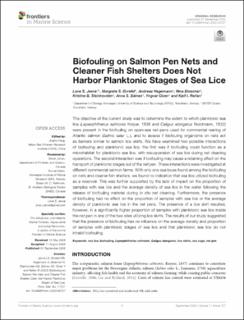| dc.contributor.author | Jevne, Lone Sunniva | |
| dc.contributor.author | Øvrelid, Margrete Slåtsve | |
| dc.contributor.author | Hagemann, Andreas | |
| dc.contributor.author | Bloecher, Nina | |
| dc.contributor.author | Steinhovden, Kristine | |
| dc.contributor.author | Båtnes, Anna Solvang | |
| dc.contributor.author | Olsen, Yngvar | |
| dc.contributor.author | Reitan, Kjell Inge | |
| dc.date.accessioned | 2020-09-29T11:45:05Z | |
| dc.date.available | 2020-09-29T11:45:05Z | |
| dc.date.created | 2020-09-10T12:45:39Z | |
| dc.date.issued | 2020 | |
| dc.identifier.issn | 2296-7745 | |
| dc.identifier.uri | https://hdl.handle.net/11250/2680289 | |
| dc.description.abstract | The objective of the current study was to determine the extent to which planktonic sea lice (Lepeophtheirus salmonis Krøyer, 1838 and Caligus elongatus Nordmann, 1832) were present in the biofouling on open-sea net pens used for commercial rearing of Atlantic salmon (Salmo salar L.), and to assess if biofouling organisms on nets act as barriers similar to salmon lice skirts. We have examined two possible interactions of biofouling and planktonic sea lice, the first was if biofouling could function as a microhabitat for planktonic sea lice, with resuspension of sea lice during net cleaning operations. The second interaction was if biofouling may cause a retaining effect on the transport of planktonic stages out of the net pen. These interactions were investigated at different commercial salmon farms. With only one sea louse found among the biofouling on nets and cleaner fish shelters, we found no indication that sea lice utilized biofouling as a reservoir. This was further supported by the lack of impact on the proportion of samples with sea lice and the average density of sea lice in the water following the release of biofouling material during in situ net cleaning. Furthermore, the presence of biofouling had no effect on the proportion of samples with sea lice or the average density of planktonic sea lice in the net pens. The presence of a lice skirt resulted, however, in a significantly higher proportion of samples with planktonic sea lice inside the net pen in one of the two sites utilizing lice skirts. The results of our study suggested that the presence of biofouling has no influence on the average density and proportion of samples with planktonic stages of sea lice and that planktonic sea lice do not inhabit biofouling. | en_US |
| dc.language.iso | eng | en_US |
| dc.publisher | Frontiers Media | en_US |
| dc.rights | Navngivelse 4.0 Internasjonal | * |
| dc.rights.uri | http://creativecommons.org/licenses/by/4.0/deed.no | * |
| dc.title | Biofouling on salmon pen nets and cleaner fish shelters does not harbor planktonic stages of sea lice | en_US |
| dc.type | Peer reviewed | en_US |
| dc.type | Journal article | en_US |
| dc.description.version | publishedVersion | en_US |
| dc.source.journal | Frontiers in Marine Science | en_US |
| dc.identifier.doi | 10.3389/fmars.2020.00727 | |
| dc.identifier.cristin | 1828716 | |
| dc.description.localcode | Copyright © 2020 Jevne, Øvrelid, Hagemann, Bloecher, Steinhovden, Båtnes, Olsen and Reitan. This is an open-access article distributed under the terms of the Creative Commons Attribution License (CC BY). The use, distribution or reproduction in other forums is permitted, provided the original author(s) and the copyright owner(s) are credited and that the original publication in this journal is cited, in accordance with accepted academic practice. No use, distribution or reproduction is permitted which does not comply with these terms | en_US |
| cristin.ispublished | true | |
| cristin.fulltext | original | |
| cristin.qualitycode | 1 | |

